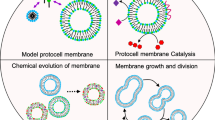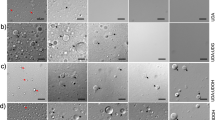Abstract
The physicochemical conditions of the environment in which life arose are discussed, along with the appearance of protocells, their membranous envelope and the subsequent appearance of plasma membranes. The hypothesis that the first cells originated in reservoirs where potassium and magnesium salts (necessary for protein synthesis and thus for the formation of a cellular membrane) dominated, is substantiated. This was followed by adaptation of these cells to an external ocean-like environment, where sodium salts were prevalent. This stage of evolution required a plasma membrane capable of providing ion asymmetry between the cell’s cytoplasm and the external environment. At this stage of evolution in the predecessors of animals, the process of removal of sodium ions and accumulation of potassium ions began functioning in the plasma membrane. The problem of multicellular organisms was solved differently by animals and plants: animals developed a system of the extracellular fluids that provided stable physicochemical conditions on the external surface of the plasma membrane. Sodium ions were the stimulus for the formation of the polar cell, where sodium channels are situated on one side of the plasma membrane, and sodium pumps on the other, allowing the development of the absorption, excretion and breathing functions. The formation of fluids of the internal environment enabled the development of homeostasis and facilitated the biological progress of the animal kingdom.
Similar content being viewed by others
References
J. Diamond, “Evolutionary Physiology,” in The Logic of Life, Ed. by C. A. R. Boyd and D. Noble (Oxford Univ. Press, Oxford, 1993), pp. 89–111.
E. Epstein, Mineral Nutrition of Plants: Principles and Perspectives (Wiley, New York, 1977).
E. M. Galimov, Phenomenon of Life: Between Equilibrium and Nonlinearity. Origin and Principles of Evolution (Moscow, Editorial URSS, Moscow, 2001) [in Russian].
A. G. Ginetsinskii, Physiologic Mechanisms of the Water and Salt Balance (Acad. Nauk SSSR, Moscow-Leningrad, 1963) [in Russian].
S. J. Gould, “Evolution of Organisms,” in The Logic of Life, Ed. by C. A. R. Boyd and D. Noble (Oxford Univ. Press, Oxford, 1993), pp. 15–42.
R. N. Hardy, Homeostasis: Series Institute of Biology’s Studies in Biology, No. 63 (Edward Arnold, London, 1976; Mir, Moscow, 1986).
H. D. Holland, The Chemical Evolution of the Atmosphere and Oceans: Princeton Series in Geochemistry (Princeton Univ. Press, Princeton, N.J., 1984; Mir, Moscow, 1989).
D. Kültz and D. Chakravarty, “Hyperosmolality in the Form of Elevated NaCl but not Urea Causes DNA Damage in Murine Kidney Cells,” Proc. Natl. Acad. Sci. USA 98,(4), 1999–2004 (2001).
R. N. Khuri, “Electrochemistry of the Nephron,” in Transport Organs, Ed. by G. Giebisch (Springer-Verlag, Berlin, 1979), pp. 47–95.
P. Kjellbom, C. Larsson, I. Johansson, et al., “Aquaporins and Water Homeostasis in Plants,” Trends Plant Sci. 4,(8), 308–314 (1999).
E. Krol and K. Trebacz, “Ways of Ion Channel Gaiting in Plant Cells,” Ann. Bot. 86, 449–469 (2000).
U. Kutschera and K. J. Niklas, “The Modern Theory of Biological Evolution: An Expanded Synthesis,” Naturwissenschaften 91,(6), 255–276 (2004).
B. R. Maden and R. E. Monro, “Ribosome-Catalyzed Peptidyl Transfer. Effects of Cations and pH Value,” Eur. J. Biohem. 6, 309–316 (1968).
Yu. I. Moskalev, Mineral Metabolism (Meditsina, Moscow, 1985) [in Russian].
Yu. V. Natochin, “The Role of Sodium Ions as a Stimulus for the Evolution of Cells and Multicellular Animals,” Paleontol. Zh., No. 4, 19–24 (2005) [Paleontol. J. 39 (4), 358–363 (2005)].
Yu. V. Natochin, “Physicochemical Determinants of Physiological Evolution: From Protocell to Man,” Ros. Fiziol. Zh. im. I.M. Sechenova 92,(1), 57–71 (2006).
Yu. V. Natochin and R. G. Parnova, “Osmolality and Electrolyte Concentration of Hemolymph and the Problem of Ion and Volume Regulation of Cells in Higher Insects,” Comp. Biochem. Physiol. 88A(3), 563–570 (1987).
Yu. V. Natochin and T. V. Chernigovskaya, “Evolutionary Physiology: History, Principles,” Comp. Biochem. Physiol. 118A 63–79 (1997).
C. L. Prosser, “Inorganic Ions,” in Comparative Animal Physiology, Ed. by C. L. Prosser and F. A. Brown (W.B. Saunders, Philadelphia, Pennsylvania, 1961; Mir, Moscow, 1977), pp. 57–76.
A. Yu. Rozanov, “Fossil Bacteria, Sedimentogenesis, and the Early Biospheric Evolution,” Paleontol. Zh., No. 6, 41–49 (2003) [Paleontol. J. 37 (6), 600–608 (2003)].
L. I. Salop, History of the Earth in the Precambrian (Nedra, Leningrad, 1982) [in Russian].
S. E. Schnoll, Physicochemical Factors of Biological Evolution (Nauka, Moscow, 1979) [in Russian].
H. Smith, “The Evolution of the Kidney,” in H. Smith Lectures on the Kidney (Univ. Kansas Press, Kansas, 1943), pp. 1–24.
A. S. Spirin and Gavrilova L.P., Ribosome (Nauka, Moscow, 1982) [in Russian].
Yu. V. Tchaikovsky, Science on the Development of Life. An Attempt at a Theory of Evolution (KMK, Moscow, 2006) [in Russian].
Author information
Authors and Affiliations
Corresponding author
Rights and permissions
About this article
Cite this article
Natochin, Y.V. The origin of membranes. Paleontol. J. 44, 860–869 (2010). https://doi.org/10.1134/S0031030110070142
Published:
Issue Date:
DOI: https://doi.org/10.1134/S0031030110070142




